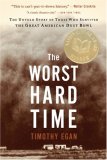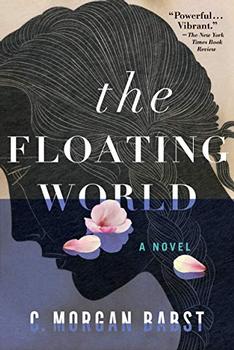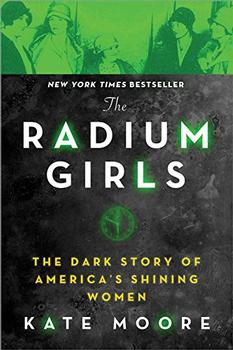Summary | Excerpt | Reviews | Beyond the book | Read-Alikes | Genres & Themes | Author Bio
The Untold Story of Those Who Survived the Great American Dust Bowl
by Timothy Egan

Critics' Opinion:
Readers' Opinion:
First Published:
Dec 2005, 320 pages
Paperback:
Sep 2006, 352 pages
 Book Reviewed by:
Book Reviewed by:
BookBrowse Review Team
Buy This Book
From the book jacket: The dust storms that terrorized America's High
Plains in the darkest years of the Depression were like nothing ever seen before
or since, and the stories of the people that held on have never been fully told.
Timothy Egan follows a half-dozen families and their communities through the
rise and fall of the region, going from sod homes to new framed houses to
huddling in basements with the windows sealed by damp sheets in a futile effort
to keep the dust out. He follows their desperate attempts to carry on through
blinding black blizzards, crop failure, and the deaths of loved ones. Drawing on
the voices of those who stayed and survived—those who, now in their eighties and
nineties, will soon carry their memories to the grave—Egan tells a story of
endurance and heroism against the backdrop of the Great Depression.
Comment: In April 1935 the biggest dust storm in US history hit five
states, from the Dakotas to Texas. On just one day in April, "Black
Sunday", more than 300,000 tons of top soil were carried away (twice as much
dirt as was taken out of the Panama Canal during seven years of construction).
Cyclical droughts and high winds are normal for the area, so we can't blame
nature for "Black Sunday" and the years that followed. The disaster was a
direct result of farming methods that had destroyed the natural ecology of the
plains in a remarkably short time. Farmers plowed up the land to plant
wheat, destroying the native deep rooting plants that held the topsoil in place,
they removed trees that acted as wind barriers, and they shot the bison in order to raise
cattle on vast ranches. In 10 years it's estimated that 25 million bison were
eradicated.
Before the end of the almost 10-year drought about a quarter
of a million people had left the Great Plains, often journeying West (such as the Joads family in
Steinbeck's The Grapes of Wrath),
but at least two-thirds hunkered down and stayed put, and it is their stories
that Egan records.
People such as George Ehrilich who, in Egan's words didn't "flee the czar's army,
survive a hurricane at sea and live through homegrown hatred caused by
the Great War just to abandon 160 acres of Oklahoma that belonged to him
and his 10 American-born children."
Egan vividly describes what the dust storms were actually like and how the
people who stayed lived out their Job-like existence as year after year they
watched their cattle starve, the vegetation die, and the dust pile ever higher.
He talks of the plagues of spiders, snakes and grasshoppers (aka locusts) that
exploded, how people tethered themselves with rope just to walk a few hundred
yards from their front door, and how the children coughed themselves to death
with "dust pneumonia".
"It was not a rain cloud. Nor was it a cloud holding ice pellets. It was not a twister. It was thick like coarse animal hair; it was alive. People close to it described a feeling of being in a blizzard — a black blizzard, they called it — with an edge like steel wool."
While Egan has nothing but admiration for the individual
farmers caught up in the devastation, he has a harsher view for the policies,
and the people behind the policies, that managed to eradicate the "greatest grassland in the world"
in an historical blink of an eye.
Could history repeat itself? Of course it could! Currently the same
region is experiencing
a period of drought, but the large agribusinesses continue to run vast
farms by drawing on the
Ogallala Aquifer
- a huge, but not inexhaustible, water source created 15,000 years ago
when the glaciers melted.
"Nothing compares to the black dusters of the
1930s, when the simplest thing in life — taking a breath — was a
threat."
- A survivor, whose life spanned the 1918 flu epidemic, the Great Depression and
two world wars.
![]() This review
first ran in the September 6, 2006
issue of BookBrowse Recommends.
This review
first ran in the September 6, 2006
issue of BookBrowse Recommends.

If you liked The Worst Hard Time, try these:

by C. Morgan Babst
Published 2018
A dazzling debut about family, home, and grief.

by Kate Moore
Published 2018
The incredible true story of the women who fought America's Undark danger.





The House on Biscayne Bay
by Chanel Cleeton
As death stalks a gothic mansion in Miami, the lives of two women intertwine as the past and present collide.

The Flower Sisters
by Michelle Collins Anderson
From the new Fannie Flagg of the Ozarks, a richly-woven story of family, forgiveness, and reinvention.

The Funeral Cryer by Wenyan Lu
Debut novelist Wenyan Lu brings us this witty yet profound story about one woman's midlife reawakening in contemporary rural China.
Your guide toexceptional books
BookBrowse seeks out and recommends the best in contemporary fiction and nonfiction—books that not only engage and entertain but also deepen our understanding of ourselves and the world around us.